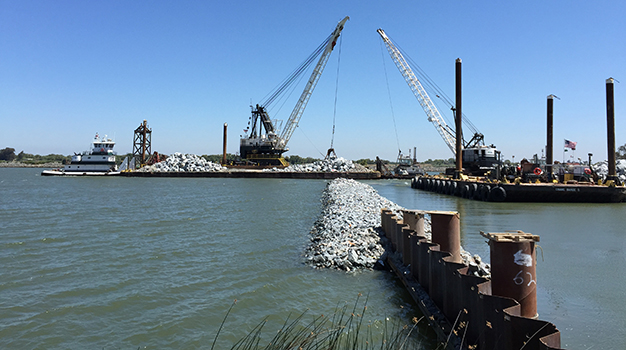Faced with potentially insufficient water supplies to repel salinity in the Sacramento - San Joaquin Delta, the California Dept. of Water Resources (DWR), in consultation with federal and state water and wildlife agencies, has moved to install an emergency, temporary rock barrier across a Sacramento-San Joaquin Delta channel.

Dutra Construction is installing a temporary emergency salinity barrier across the West False River in the Sacramento-San Joaquin Delta channel to help deter the tidal push of saltwater from San Francisco Bay into the central Delta. Photo courtesy of Dutra Construction
By BC Staff
Published: June, 2015
Faced with potentially insufficient water supplies to repel salinity in the Sacramento - San Joaquin Delta, the California Dept. of Water Resources (DWR), in consultation with federal and state water and wildlife agencies, has moved to install an emergency, temporary rock barrier across a Sacramento-San Joaquin Delta channel.
San Rafael-based Dutra Construction, a division of the Dutra Group, began installation of a single emergency salinity barrier across West False River in early May, to be removed six months later in November. State and federal water and wildlife officials determined that the barrier would help deter the tidal push of saltwater from San Francisco Bay into the central Delta. The barrier is essentially a pile of basketball-size rocks across the 750-foot-wide channel that still allows limited water flow upstream and downstream, depending upon tides.
Keeping saltwater from the central Delta is a priority because a large portion of the state’s freshwater supplies travel through this part of the Delta. The barrier will help prevent saltwater contamination of water supplies used by people who live in the Delta; Contra Costa, Alameda and Santa Clara counties; and the 25 million people who rely on the Delta-based federal and state water projects for at least some of their supplies.
Typically, when saltwater threatens to encroach deeper into the Delta, water project operators try to repel it either by slowing the pumping of water from the Delta or increasing the amount of water flowing into the Delta from upstream reservoirs. In this fourth year of drought, however, Delta pumping by the state and federal water projects is already negligible. It takes three to five days for fresh water released from Lake Oroville or Shasta Lake to reach the Delta. The emergency barrier will provide an additional tool to help limit salinity intrusion prior to arrival of fresh water from upstream reservoirs.
“We had hoped not to have to install any temporary emergency barriers in the Delta this year,” said DWR Director Mark Cowin. “But conditions stayed dry through March and April. The West False River emergency barrier would provide a buffer that otherwise would have come from reduced Delta pumping. This summer, there is no Delta pumping to reduce. The barrier would help afford us time to move water from Oroville and Shasta should we need to push back saltwater intruding into the Delta.”
The emergency barrier will also help mitigate a worst-case scenario this summer in which upstream reservoirs lack sufficient water to meet the minimum outflow requirements to limit Delta salinity intrusion. Dutra Construction is set to complete the barrier by mid-June to meet a 45-day construction deadline.
The trapezoid-shaped barrier, about 12 feet wide at the top, will temporarily block boat passage on West False River and will be marked by warning signs, lights and buoys. Alternative routes between the San Joaquin River and interior Delta, including Bethel Island marinas, are available. The West False River site, about 4.8 miles northeast of Oakley, raised fewer concerns for threatened and endangered fish than other potential barrier sites considered by the state.
Construction, monitoring, mitigation and removal are estimated to cost roughly $28 million, to be paid for with a mix of funding from Proposition 50, a $3.4 billion water bond approved by voters in November 2002, and general fund dollars. Emergency barrier removal is planned to finish no later than November 1 to avoid flood season and potential harm to migratory fish. Removal is expected to take 45 to 60 days. DWR last used emergency drought barriers to reduce salinity intrusion in 1976-77.
The three-year period from 2012 through 2014 was the driest three-year period on record in California, and 2015 opened with the driest January in the state’s history. The Sierra Nevada snowpack typically peaks by April 1; this year, the snowpack was measured at five percent of historic average, the lowest measurement in recorded history.
Conservation—the wise, sparing use of water—remains California’s most reliable drought management tool. Each individual act of conservation, such as letting the lawn go brown or replacing a washer in a faucet to stop a leak, makes a difference over time.

